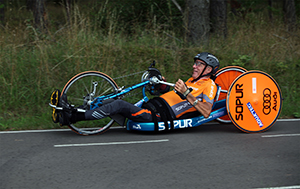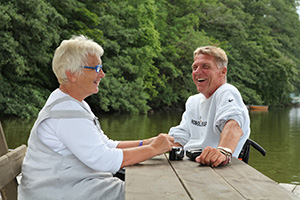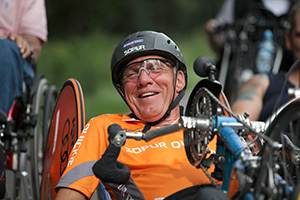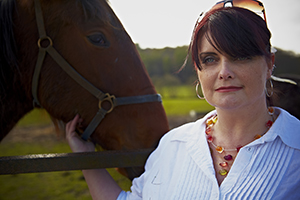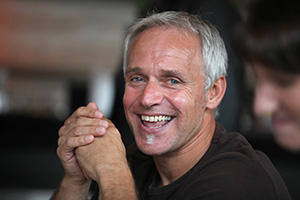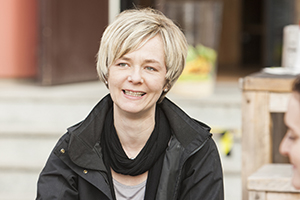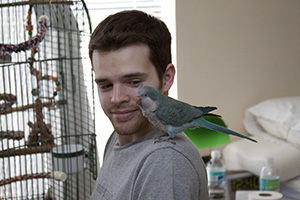Stories of Triumph and Inspiration
Heinrich Köberle, Germany
There are people who live on a mountain their whole lives. Farming, herding, keeping house. Their lives are typically solitary; even the lives of cohabitants can be described this way. Perhaps it’s the resounding stillness that typifies elevations above the tree line, where echoes reverberate for miles and miles, elegies of windswept sound streams. In the mountains, solitariness is pure song.
Heini was raised on Obermaiselstein, near Oberstdorf, in Germany. His mountain (mountain dwellers take possession of their mountains) rises 1,700 m above sea level. Heini knew his way around that mountain as well as any roaming shepherd. Like his father did, and his father’s father did, his brother maintains the family farm — now a converted guesthouse for journeyers.
1969. Heini, like every one of his male contemporaries, is obligated to enlist in the German armed forces. Staunch agile highlander that he is, Heini is assigned to the elite Gebirgsjäger, in Mittenwald, a mountain infantry of 15 elite soldiers whose detail includes mountain climbing and skiing. He learns the value of teamwork and discipline — values around which his life from that point forward is based.
Good fortune arises out of misfortune (provided one is disposed to see things in this way; not everyone is). “We all need luck,” says Heini, whose light blue eyes sparkle like a mountain rivulet in the sun. “It’s very difficult to get along in life without it.” Gudrun is a manifestation of Heini’s luck, and vice versa. They met in a local pub. He was seated at a table, and she was fresh from the handball court and had come in to have a drink with her friends. Conversation came easily to them both that evening in 1971. Fortune had her way.
Two years prior, in the early hours of a mild May morning, on a narrow country lane, Heini winds his way through a thick forest of thinning trees. His headlights pierce the shadowy depths. The four-cylinder engine claps, the tyres whir. More speed. A sharp turn. His mother never gets over it. She prays for a miracle, as if he is no longer whole. She makes a pilgrimage to Lourdes. Returns again and again to Altötting, in Bavaria, to beseech the Black Madonna. Help my son, she pleads, Heal him.
The car skids out of control around the curve and flips, leaving Heini mangled and twisted by the side of the road, conscious but motionless. His neck is broken. He is completely paralysed. He feels nothing. He knows he will feel nothing ever again; neither the push of sand between his toes, nor the smooth coolness of a Bakelite steering wheel in the grip of his hands; nothing, save the breeze stroking his bruised face, save the wealth of feeling that is the domain of the human heart. The sun low in the sky, the road still, the surroundings silent. Heini knows his life has been forever changed by the swift indiscriminate hand of Fortune. He knows, too, that he will carry on.
“Life is what you make it.”
He must bid his mountain adieu. There will be no more climbing, no trekking, no skiing. But what he cannot in that moment foresee is that the altitudes he has known will become heights of a different order. Moral heights. Spiritual heights. The heights of athletic achievement. The pinnacle of love.
After years of fervent prayer, Heini’s mother embraces the miracle that Heini embraced that fateful afternoon. Not only had her son survived, not only had he beaten the odds (the doctors predicted Heini would live another five years, 10 years at the most), Heini flourished. He is flourishing still.
1984, Stoke Mandeville, UK. The first time that a Men’s 1A Marathon for wheelchair athletes is held during the Paralympic Games (1A is the category for the most severely disabled athletes like Heini, who is a C5/6 quad). Heini was the only one to finish, winning his first of four consecutive gold medals in this Paralympic event: Stoke Mandeville 1984; Seoul 1988; Barcelona 1992; Atlanta 1996. He competed in his last Paralympic wheelchair marathon in Sydney 2000, winning silver. In all, Heini competed in more than 160 marathons and road races around the world. He spun his best time at the Berlin marathon in 1995, setting the world record in his category of 2:23:08.
Heini and Gudrun — lifelong partners, companions, lovers, soul mates, friends. They readily acknowledge their luck and share the same philosophy of life.
“Be the change you are looking for.”
On behalf of the German Wheelchair Sports Federation, Heini and Gudrun work with and train junior wheelchair athletes, modelling such qualities as responsibility, determination, skill, courage and grit. They model these same qualities during sports workshops designed especially, but not exclusively, for individuals new to a wheelchair. Athletics, they believe, are about more than winning. “Medals lose their shine. Kinship, friendship and inspiring others to bring out what’s inside of them; those are the things that matter, the things that last.” They travel the globe together now visiting the many friends they have made around the world during their 39 years together. Heini works as a motivational trainer, and Gudrun manages the details. “I am not a coach,” Heini says with characteristic modesty, adding with a grin, “I share my experience, from toilet to track.”
“The pride of mountain dwellers is said to be unshakable. It is a dignified pride born of humility. Lest the mountain have its way.”
And with humility comes hope. Of all the things Heini and Gudrun bring to the people they work and interact with, hope is the most valuable because hope engenders possibility. “Die Hoffnung stirbt zuletzt.” Hope never dies. Sometimes though, we need to be reminded of its potential to heal.
“The gift is knowing you are the possibility. You are the one to make it happen. Do the work and the rewards will follow.”
